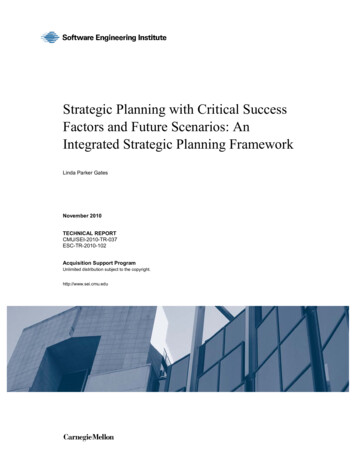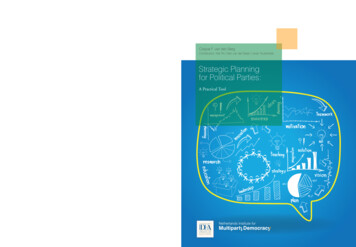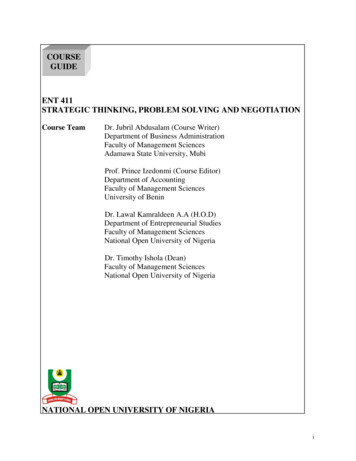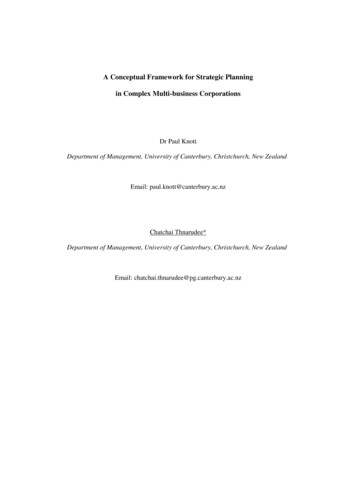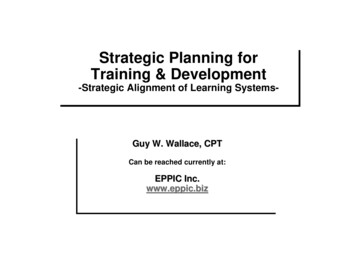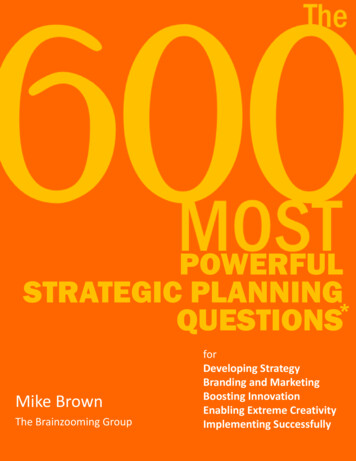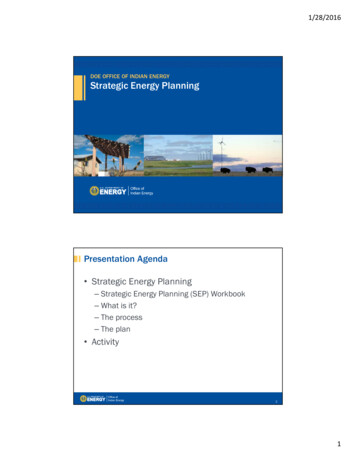
Transcription
1/28/2016DOE OFFICE OF INDIAN ENERGYStrategic Energy PlanningPresentation Agenda Strategic Energy Planning– Strategic Energy Planning (SEP) Workbook– What is it?– The process– The plan Activity21
1/28/2016Strategic Energy Plan and Planning Handbook Provides a step-by-step processthat Tribes may wish to use as aroad map for discussion anddecisions related to strategicenergy planning and energyproject prioritization Includes blank text boxes forcommunities to input their owninformation and outcomes fromenergy planning t Is Strategic Energy Planning?And what does it do for you?vs. Brings desired energy future into clear focus Considers current reality and leverages local resources Considers hurdles/challenges before you reach them Maps out efficient path to achieve your desired energy future Clarifies progress indicators Documents the game plan for short- and long-term successGraphic concepts reprinted with permission from Lesley Kabotie, Kabotie Consulting.42
1/28/2016What Makes Energy Planning “Strategic”?Inclusive Energy Planning ProcessPublic in tolong-term vision Political commitment tomobilize authority andresources Identify energy uses and futureneeds (baseline)Private SectorGraphic concepts reprinted with permission from Lesley Kabotie, Kabotie Consulting.5Strategic Energy Planning: Leadership Teamvs.Not just people with the “right” idea, but those committedto the long-term task with personal and political influenceIncludeAvoid Individuals with authority to direct resources Exclusively political appointees Individuals with a passion forthe “destination” Exclusively technical staff Exclusively implementers Individuals with influence in thecommunity and administrative abilitiesto keep the project alive Individuals with the technical ability Individuals who can “tell the story”Graphic concepts reprinted with permission from Lesley Kabotie, Kabotie Consulting.63
1/28/2016Planning Is Coordinated and Collective ActionCommunityTechnical StaffLeadership StaffPartnersTribal LeadershipProper planning and strategic energy plan development helps stakeholders: Direct action Sustain momentum Motivate involvement Reduce/minimize reactive decision-making Go the distanceGraphic concepts reprinted with permission from Lesley Kabotie, Kabotie Consulting.7Why Does Strategic Energy Planning Fail? Short-sighted predictions of the situation, timeline Unrealistic predictions of resources Uncoordinated implementation Narrow ownership Failure to follow the plan Poor, or casual, communicationGraphic concepts reprinted with permission from Lesley Kabotie, Kabotie Consulting.84
1/28/2016Steps in Strategic Energy PlanningIdentify/ConveneStakeholdersMeasurement &Verification (M&V) andPlan AlterationsForm LeadershipTeamCompile Energy PlanDevelop Energy VisionIdentify FinancingOptionsPrioritize Projects &ProgramsAssess Energy Needsand ResourcesDevelop Specific Goals9Strategic Energy Planning: First StepsIdentify/ConveneStakeholdersForm LeadershipTeamDevelop Energy Vision105
1/28/2016First Steps: Identify and Convene Stakeholders Tribal membersTribal councilTribal governmentTribal utilities Tribal enterprises Large energy users Local utilitiesKey success component:Identify and select an energy“champion” to shepherd the processPhoto by Karen Petersen, NREL11Activity Identify Key Stakeholders126
1/28/2016Case in Point: Tribal RolesAkwesasne Housing Authority/St. Regis Mohawk Tribe, NY Applied for help with strategic energy planning throughDOE’s technical assistance program Initial strategic energy planning workshop was held inJanuary 2015 in Florida While productive, the Tribe realized that not all of theright people were in the room to participate in developingthe plan, which is critical for community buy-in The Tribe applied for and was selected to receiveadditional technical assistance from DOE for a follow-onstrategic energy planning workshop with additionalattendees from the Tribe, which was held at theAkwesasne Mohawk Casino Conference Center June 2–413January 2015 Workshop Invitees/AttendeesTribal Division/EntityRoleJob Title1.Akwesasne Housing AuthorityHousing AdministrationExecutive Director2.Akwesasne Housing AuthorityHousing Finance/AdministrationFinance Director3.Akwesasne Housing AuthorityHousing, ConstructionOperations Manager4.Akwesasne Housing AuthorityHousing, Construction PlanningOperations Planner5.Akwesasne Housing AuthorityHousing ServicesHousing Services Manager6.Akwesasne Housing AuthorityHousing GovernmentCommissioner of Housing7.Akwesasne Housing AuthorityHousing GovernmentCommissioner of Housing8.Akwesasne Housing AuthoritySpecial Housing ProjectsSpecial Projects Coordinator9.St. Regis Mohawk TribeTribal GovernmentTribal Sub-Chief10.St. Regis Mohawk TribeInfrastructureDirector of Infrastructure & Planning11.St. Regis Mohawk TribeTribal Special ProjectsCapital Projects Manager12.St. Regis Mohawk TribeEconomic Development (invited)Economic Development Planner13.St. Regis Mohawk TribeEnvironment (invited)Director of Environment14.St. Regis Mohawk TribeEnvironment (invited)Air Quality Program Manager15.Beardsley Design AssociatesA&EAHA’s Chief Design Architect16.Beardsley Design AssociatesA&EAHA’s Project Engineer147
1/28/2016June 2015 Workshop 18.19.20.Tribal Division/EntityAkwesasne Housing AuthorityAkwesasne Housing AuthorityAkwesasne Housing AuthorityAkwesasne Housing AuthorityAkwesasne Housing AuthorityAkwesasne Housing AuthorityAkwesasne Housing AuthorityAkwesasne Housing AuthorityAkwesasne Housing AuthoritySt. Regis Mohawk TribeSt. Regis Mohawk TribeSt. Regis Mohawk TribeSt. Regis Mohawk TribeSt. Regis Mohawk TribeSt. Regis Mohawk TribeSt. Regis Mohawk TribeSt. Regis Mohawk TribeSt. Regis Mohawk TribeSt. Regis Mohawk TribeSt. Regis Mohawk TribeRoleHousing AdministrationHousing Finance/AdministrationHousing ConstructionHousing Construction PlanningHousing ServicesHousing ServicesHousing ServicesHousing GovernmentSpecial Housing ProjectsTribal GovernmentTribal GovernmentTribal lth Critical Care – OutreachInfrastructureTribal Special ProjectsJob TitleExecutive DirectorFinance DirectorOperations ManagerOperations PlannerHousing Services ManagerHousing Services AdvocateHousing FinancingCommissioners of Housing (7)Special Projects CoordinatorTribal Chiefs (3)Tribal Sub-Chiefs (3)Tribal AdministratorGeneral CounselFinance DirectorDirector of EducationDirector of Health ServicesAssistant Director of Health ServicesManager of OutreachDirector of Infrastructure & PlanningCapital Projects Manager15June 2015 Workshop Invitees 36.37.38.39.40.41.Tribal Division/EntitySt. Regis Mohawk TribeSt. Regis Mohawk TribeSt. Regis Mohawk TribeSt. Regis Mohawk TribeSt. Regis Mohawk TribeSt. Regis Mohawk TribeSt. Regis Mohawk TribeSt. Regis Mohawk TribeSt. Regis Mohawk TribeSt. Regis Mohawk TribeSt. Regis Mohawk TribeSt. Regis Mohawk TribeSt. Regis Mohawk TribeSt. Regis Mohawk TribeSt. Regis Mohawk TribeMohawk Indian Housing Corp.Akwesasne MuseumAkwesasne LibraryAkwesasne Boys & Girls ClubBeardsley Design AssociatesBeardsley Design AssociatesRoleEconomic DevelopmentEconomic anceGrants/Contracts ManagementEmergency ServicesSenior ServicesSocial & Human ServicesPolice ServicesHuman ResourcesTribal RecordsFamily ServicesCommunicationsHousingCultural & ArchivesLibrary ServicesYouth ServicesA&EA&EJob TitleDirector, Economic DevEconomic Development PlannerDirector of EnvironmentAssistant Director of EnvironmentAir Quality Program ManagerDirector of ComplianceGrants & Contracts ManagerEmergency Planning ManagerOffice of the Aging DirectorDirector of Social ServicesChief of PoliceHR DirectorRecords Department ManagerManager of Each Program Area (9)Director of CommunicationsDirector of HousingMuseum ManagerLibrary ManagerDirector of AB&GCAHA’s Chief Design ArchitectAHA’s Design Engineer168
1/28/2016First Steps: Form a Leadership TeamDraw from the stakeholders: Tribal council member(s) Tribal government executives Tribal member representative(s) Tribal enterprise leader(s)Photo by Dennis Schroder, NREL17First Steps: Develop an Energy VisionCommon objectives include: Increase and ensure energy reliability Minimize environmental impacts Diversify energy supply Use local, renewable resources Strengthen, support economic development Build workforce/jobsDOE-IE Foundational Strategic Energy Planning Ensure energy affordability Generate revenue for Tribe Energy security/self-sufficiency Off-grid electrification Save money (offset energy costs) Keep money in Tribe Stabilize energy costs for Tribe andtribal members.Photo by Karen Petersen, NREL189
1/28/2016Energy Vision Example: Blue Lake Rancheria, CAUltimately achieve 100% self-sufficiency through renewable energyRancheria-wide.Initiatives to achieve this include: Blue Lake Hotel Energy Model (First in CA, 17%energy reduction)Energy Efficiency ProgramsCasinoGreen Program Low-flow PlumbingDOE-IE Foundational Strategic Energy PlanningEconomizers on Air ConditionersUpgraded 100% HVAC to High- efficiency Standards andRatingsTimely Filter ReplacementsInsulated WindowsAll Lighting (bulbs, fixtures) Compliant with CurrentU.S./California Energy CodeBlue Lake Rancheria Vice Chairperson Aria Ramsey andAll New and Replacement Lighting is LED (wherever possible)Energy Director Jana Ganion at the Tribe’s biomass-to-fuelcell power plan. Photo from Jana Ganion, NREL 32766Insulation Compliant with California Building CodeRecycling Program (70 tons/year)Biodiesel Transit (2014)Energy AuditsRenewable Energy FeasibilityWaste to Energy FeasibilityDrought-resistant LandscapingSource: ech.html19Energy Vision Example: Forest County Potawatomi, WIUltimately reduce the Tribe's carbonfootprint to zero while leading energystrategy initiatives, which supportand promote the efforts of othersworking to reduce their own carbonfootprints.Accomplishments toward DOE-IEthisFoundationalgoal toStrategic Energy Planningdate include: A 30-kilowatt (kW) rooftop solar photovoltaic array thatpowers the Tribe’s administration building in MilwaukeeA 2-megawatt anaerobic digester and biogas generationfacility that converts food waste into electricity to power1,500 homesAn LED lighting project at the Tribe’s parking facilities thatreduced electricity use by more than 47%Energy efficiency upgrades to the Tribe’s historic WunderHall building, which now houses the Tribe’s economicdevelopment center, expected to save the Tribe more than50% on energy costsEnergy audits of the Tribe’s Carter Hotel and Casino toidentify potential energy and money-saving upgrades.The Forest County Potawatomi Tribe’s 30-kW solar PV system on theroof of its administration building in Milwaukee, WI. Photo from theForest County Potawatomi Tribe, NREL 20107.Source: ments2010
1/28/2016Strategic Energy Planning: Priorities & DecisionsIdentify FinancingOptionsPrioritize Projects &ProgramsAssess Energy NeedsDevelop Specific Goals21Priorities & Decisions: Assess Energy NeedsDocument the community baseline: Determine energy use by “sector” includinggovernment, residential, school, commercial Use available tools:– Energy audits– EPA Portfolio Manager(non-residential buildings) Forecast future load– New housing– New government facilities– New/expanded enterprisesPhoto by Alex Dane, NREL 22724 Verify current service providers and rates forelectricity, gas, propane, wood, and others2211
1/28/2016Priorities & Decisions: Develop Specific GoalsExamples: Reduce electricity use by % by 2022 Obtain % of electricity from renewable sources within10 years (similar to a renewable portfolio standard or RPS) Reduce energy costs by % within 5 yearsPhoto by Karen Petersen, NREL23Priorities and Decisions: Prioritize Projectsand Programs Develop a ranking system to understandcost-effectiveness of different projects Best practice models:– Total resource cost Model considers life-cycle benefits for projects– Levelized cost of energy Allows comparison across different technologies Tribal energy policy/program examples:– Incentives to reduce energy use– Incentives to promote renewable energy– Sustainable/green building codes,standards, or other requirementsor guidelinesPhoto by Bob Gough, NREL 159542412
1/28/2016Priorities and Decisions: IdentifyFinancing OptionsSecure planning and project funding sources: Tribal funding(energy.gov/indianenergy/fedprograms) DOE TechnicalAssistance (TA) Program Other federal agencyTA and grant programs State programs Non-governmentalorganizations (NGOs)Photo by Alex Dane, NREL25Strategic Energy Planning: Energy PlanM&V and PlanAlterationsCompile Energy Plan2613
1/28/2016Energy Plan: Purpose and FunctionsPurposeFunctions Documentnear-term goals Creates “road map” to holdaccountability to thedestination Sustainmomentum Achievelong-term goals Provides the means toconsistently share the storywith others Creates resources to helpguide and filter priorities,providers, and decisions27Energy Plan: ComponentsInclude: Vision Objectives Goals Baseline Barriers Program/project options– Demand side– Generation Recommendations Adoption by Tribal CouncilPhoto by Paul Dearhouse, NREL 245032814
1/28/2016STRATEGIC ENERGY PLANNINGCASE IN POINT29Tribal Case in Point: How Did It Work?Ho-Chunk Nation, WIProvided Tribe with a preliminary report that: Established a community energy baseline– Identified available renewable energy resources– Outlined energy efficiency and infrastructureconsiderations– Presented a high-level market/economic overview– Surveyed the policy landscape Provided a preliminary assessmentof the Tribe’s best opportunitiesfrom a resource and economicperspective3015
1/28/2016Tribal Case in Point: How Did It Work? (Cont.)Facilitated an on-site Community Energy Planning Workshop Day 1: Historical Review and Current Reality– Document community energy experiences and expectations– Discuss tribal values, priorities, energy goals– Identify recurring obstacles and challenges– Establish consensus-based energy vision Day 2: Strategy Development– Technical resource presentations (National Renewable Energy Laboratory)– Small group strategy sessions to prioritize actions for energy development, establish12-year focus, articulate innovative strategies Day 3: Implementation– Brainstorm strategies/tactics for overcoming obstacles– Develop 3-month agenda for building support for tribal energy vision– Establish 1-year timeline of specific actions for mobilizing strategies31Tribal Case in Point: How Did It Work? (Cont.)Delivered final report documenting: Key drivers for energy development– Energy independence: Socially responsible standards to govern energydevelopment– Energy efficiency and cost savings: Diverse power generation andefficient, affordable energy practices for homes and businessesnationwide– Sustainability: Energy-focused education, training, and jobs Decisions and strategies– Open new opportunities and pierce through obstacles—launchstakeholder engagement and education campaign– Build critical mass and support for energy development—research existingenergy facilities and benchmark successful practices; integrate andimplement energy program initiatives– Support long-term stability and viability of energy development—createpolicies, codes mandating energy efficiency; designate responsibility andoversight for energy development3216
Notes
Notes
Nonprofit Stakeholder buy-in to long-term vision Political commitment to . 27. St. Regis Mohawk Tribe Grants/Contracts Management Grants & Contracts Manager 28. St. Regis Mohawk Tribe Emergency Services Emergency Planning Manager 29. St. Regis Mohawk Tribe Senior Services Office of the Aging Director . 35. St. Regis Mohawk Tribe Communica .


